
Intro Card for 1991 Oak Cliff Eyeball Killer
Hello there! It’s Brenda from Vintage Texas Crimes with a story today from the early 1990s in Oak Cliff, an old community within Dallas.
For a number of years, prostitutes had seen a tall, handsome man coming out at night to solicit their services. In the early years, he was a friend to these women, but as time went on, he became rough and demanding in the red-light district. He frightened them. Then there were the bodies of their friends … and they were missing their eyes.
Okay! Let’s get to it!
The Crimes

Mary Pratt
In December 1990, Mary Pratt, a white prostitute, was found naked and shot dead in a lower-class area of south Dallas. During the autopsy, Dr. Elizabeth Peacock discovered that her eyeballs had been surgically removed, and no injury left to the surrounding skin or eyelids. (I am mentioning ethnicity because, for a while, prostitutes thought it would only happen to whites..)
Soon after Pratt’s death, the officers on the beat where the murder happened picked up a man and woman who dropped two hot clues on them that would not resonate for another year.

Veronica Rodriguez
That night, Officers John Matthews and Regina Smith encountered prostitute Veronica Rodriguez with a gash on her forehead. She willingly reported a “psycho” raped her and tried to kill her, saying he hated “whores.” She described a man with salt and pepper hair who was tall. When the cops ran into Veronica, she was in a man’s truck. His name was Axton Schindler and Veronica said he was a friend who had tried to protect her from the killer.
Schindler had a different story. He said he had known her for years and was just giving her a ride to the motel. He claimed he didn’t protect her from any killer—there was no “killer.” Schindler said he was just a long-distance truck driver doing her a favor. Rodriguez, the officers decided, was lying once again, as she was prone to do when she wanted pity.
They carted her to jail for prostitution, and after looking at Schindler’s driver license, they hauled him in for his unpaid tickets.

Susan Peterson
Fast forward to January 1991—Susan Peterson, a white prostitute working in Oak Cliff, was found murdered, also with her eyeballs surgically removed. This linked the killings and prompted police to hunt for someone who was a “twisted, brilliant murderer,” maybe even a doctor or medical student.
White prostitutes became very wary and slowed down going with tricks they didn’t know, but black prostitutes thought they weren’t the killer’s type. They continued to operate without concern, but all that changed two months later.
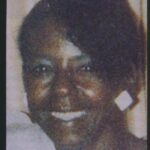
Shirley Williams
In March 1991, Shirley Williams, an African American prostitute, was found murdered on a residential street in Oak Cliff, half a block from an elementary school. Her eyeballs were also surgically removed, confirming a third linked killing and a change in the killer’s dumping ground.
Three days later, Brenda White, another African American prostitute, reported that she had encountered a “husky-looking white man with salt-and-pepper hair, cowboy boots, and blue jeans” in a dark station wagon. When she refused to go to his “spot,” where he wanted to take her, he became enraged, saying, “I hate whores! I’m going to kill all of you motherf—ing whores!” White escaped by macing her attacker.

Officer John Mathews: instrumental in breaking the case.
The Investigation
Officers John Mathews and Regina Smith realized White’s description of the threatening man sounded familiar and much like Veronica Rodriguez’s story. The officers decide to go talk to them again; they also wanted to figure out who Axton Schindler was. Using Dallas County’s government computers, they started searching. They wanted to talk to both Veronica Rodriguez and her friend.
Fortunately, they already had Axton Schindler’s address of 1035 Eldorado in Dallas from the earlier arrest, and they typed it in which revealed the owner of the property was a dead man named “Fred Albright.”

Officer Regina Smith who was instrumental in breaking the case.
More searches brought up Fred’s son, Charles Albright, and his personal information. At this point, the officers had Charles Albright’s name, birthdate, and they learned he actually lived at 1035 Eldorado. With that information, they were able to search for a criminal record.
Eureka! They hit pay dirt; his record included thefts, burglaries, forgeries, fraud, and a child sexual abuse charge. His mug shot also matched Brenda White’s description.

One of Albright’s many mugshots
Officers Mathews and Smith arranged for a photo lineup for Brenda White; she identified Charles Albright as the man who attacked her. Veronica Rodriguez came in as well, and she picked Albright from the lineup as the man who assaulted her.
With White’s and Rodriguez’s identification, police obtained a search warrant for Albright’s residence at 1035 Eldorado. There they found carpentry tools, woodworking blades, X-Acto blades, a copy of Gray’s Anatomy, true-crime books, and a hidden compartment with pistols and rifles.

Another of Albright’s many mugshots
Charles Albright was handcuffed and arrested. Dixie Austin, Albright’s long-time common law wife, was present during the arrest, and she screamed in shock and disbelief that Charles could be accused of the murder of at least three women.
He was found guilty, of course, and sentenced to life, and he never admitted a thing about guilt. But really, aren’t the crimes just a fraction of what we really want to know about?
We seldom come to the story to hear the gory details of the crimes. We come to know who the killers really are … what caused him to be like he was … what his parents were like … and his living conditions when he was a child growing up.
And what were the signs that had shown that a nice man like Charles Albright might be a killer? What we often really want to know is: How can we protect ourselves from people like him?
And for those lessons, we must go all the way back to the beginning.
Oak Cliff,1933
Charles Albright, as an adult, seemed so well-rounded and helpful. Albright had been described by many who knew him as happy and of no trouble to anyone. He was thought of as a kind of Renaissance man. He was fluent in French and Spanish and he could play classical tunes on the piano like nobody’s business. Albright was a terrific softball player and talented at fixing and building things. He knew about the finer things in life; he loved art, and he could also draw and paint beautifully.
All in all, Albright was well-liked in his world. No one who knew him believed he would have solicited prostitutes, much less kill them and remove their eyes. But there was a lot of twisted thinking twirling and percolating behind Albright’s handsome face and courtly manners. To see where this might have come from, and what the signs were along the way, we’ll have to start with the roots of his childhood.
*****
The enclave city of Oak Cliff was annexed by the growing city of Dallas, in 1903. Business boomed in Oak Cliff during the 1920s, but like the rest of the world, Oak Cliff’s economy staggered under the weight of the Great Depression. High rates of unemployment caused some of its citizens to resort to crime. One of the nation’s most notorious crime duos, Bonnie and Clyde, lived in Oak Cliff. When their reign of crime ended in 1934, they were both buried (in separate cemeteries) in Dallas and Oak Cliff.
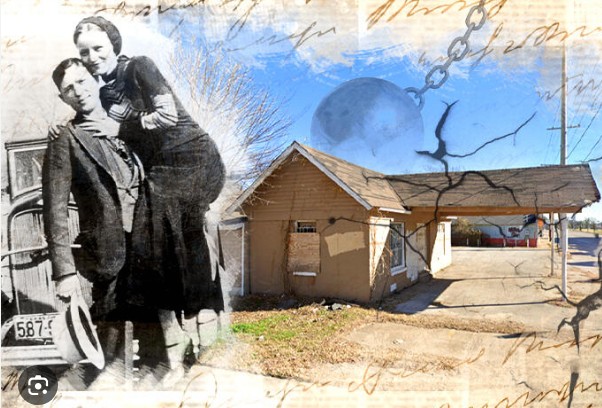
Bonnie Parker & Clyde Barrow superimposed next to the old service station owned by his father and where the Barrows also lived in Oak Cliff
But many areas of Oak Cliff were not touched by the Bonney and Clyde sort. There wonderful, safe areas in the former city and such was the residential neighborhood Charles Albright was adopted into in 1933 when he was three weeks old. He was raised across the river from downtown Dallas in Oak Cliff. His father, Fred Albright, ran a grocery store, and his mother, Delle Albright, stayed home and took care of little Charles and the house.
Delle Albright told her son his natural mother was an exceptionally bright young woman who was a law student at age 16. She and another student had married secretly and when she found herself in the family way, her father said she would be cut off from the family if she did not annul her marriage and give up the baby. In later years, Charles would say he didn’t know if that was the absolute truth. He even told some of his friends that his birth mother was a prostitute. On one occasion, Albright declared he hated all prostitutes and thought they needed killing.
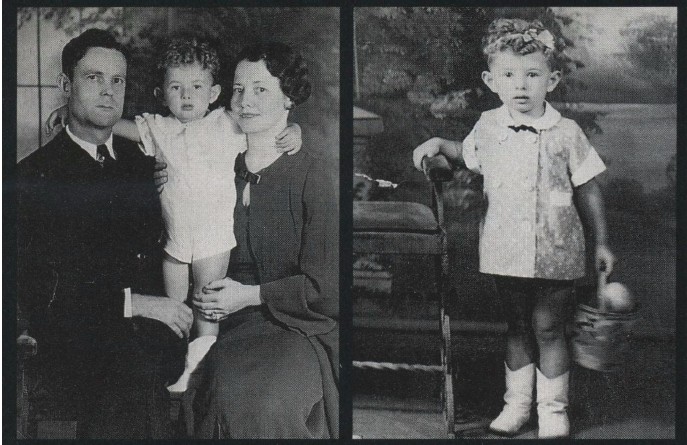
Fred Albright, young Charles, Delle; Charles in feminine clothing.
No matter who his birth parents were, Charles was a precocious little boy and Delle pampered him, but she had some odd habits that surely added a twist to her son’s warped personality. For one thing, she dressed him in little dresses and gave him a doll to hold when he was young; she also had his picture made at a studio while he wore feminine clothing. She’d also change his clothes several times a day so he would not get dirty.
She didn’t want him to touch dog feces, so she took him to a Dallas hospital to show him people in iron lungs with polio and said touching dog feces would cause him to have polio and have to live in a hospital the rest of his life in an iron lung. She spanked him for not drinking his milk, which was goat’s milk, by the way. Cow’s milk was not good enough for her child. She also locked him in a dark room to teach him not to do things.
Delle told him too much about her physical relationship with Fred Albright and told him he much never do those things which were, for instance, Fred grabbing at Delle when she was in her underclothes and being “greedy” during intimacy.
People who knew Delle said she had a grim or negative personality. She kept a scarf over her head and wore secondhand clothes from thrift stores. Although she and Fred were far from poor, she scrimped at mealtimes, even picking up the old bones the local butcher threw in a box for his dogs. She could use them, she would say, for soup. Charles hated her cooking and often fed it to his dog underneath the table.
When Charles started dating girls, she insisted on calling the parents and telling them that Charles would do nothing untoward to their daughter. But one thing that must have had a serious impact on Charles Albright was her enrolling him at age eleven in a mail order taxidermy course. I don’t know if he wanted to learn taxidermy, or if Delle wanted him to learn it. In either case, he professed to learn how to do it well as time went on.
In the beginning, Charles would find dead birds and Delle showed him how to use all the tools in his taxidermy kit: the knife used to cut the skull, the little spoon used to scoop out the brains, the scalpel required to cut away the eyes from their sockets, the forceps that pulled out the eyes. She even skinned the first bird for him, teaching him how to do it correctly.
Just reading that part makes me queasy!

Glass Bird Eyes for Taxidermy Projects
The young taxidermist wanted to purchase the lovely round glass eyes at the taxidermy supply store for his mounted birds and other animals he had learned to make lifelike, even in death. But his mother, to scrimp on money, insisted that he use discarded buttons rather than the glass eyes, which were more suitable for the task.
Because Delle pushed her son, giving him extra reading and math assignments throughout grade school, Albright advanced two grades in school and graduated from Adamson High School at age 15. Albright started to school at North Texas State in Denton when he was fresh out of high school, but he had to leave when it was discovered he was part of a student burglary ring for which he had to spend a year in prison.

Charles Albright in Arkansas college
When he was 19, he went to college in Arkansas to become a teacher. There, he was a star football player and popular with other students. He was also a prankster, taking it too far at times. Albright could do most of his work without studying and the talk was he should go to medical school.
In 1969, Charles Albright began teaching high school at Crandall, a town near Dallas. He also helped coach the Crandall football team. After football season, it was discovered that Albright didn’t have a college degree. He had faked his credentials from East Texas State University, and he had never finished in Arkansas because, again, he got kicked out for burglary.
A deal was made regarding the faked credentials and Albright’s teaching without the proper education. Albright pled guilty to fraud, receiving as his sentence a mere year’s probation. Crandall’s school district didn’t want to go through a public trial and broadcast that they had hired a man who had a record of burglaries and had not finished college.
After that, he had a few odd jobs. For instance, he went to Mexico, where he became a bullfighter. And then he was an illustrator for patents for a short time. However, he settled in for one of his longest stints in a job I would not have guessed.
Albright had a friend who worked at Sanger-Harris doing hair, and that appealed to him. He went to beauty school and actually finished, earning his cosmetology license and going to work in the Sanger-Harris salon. Albright called himself “Mr. Charles.” While being a hair stylist, he spent a great deal of time on each client getting his or her hair just right.
And then, it was 1985, and something else happened. Albright had become a dedicated, helpful member of the congregation of St. Bernard’s Catholic Church in East Dallas. Now … for this part, I am quoting directly from Skip Hollingsworth’s 1993 article mentioned in the comments.
“The incident was kept very, very quiet. There would be no trial, no headlines. The district attorney had arranged for him to serve a probated sentence of ten years, which meant no jail time.
Probation was fine with him—just as it was in 1971, when he was arrested for forging some cashier’s checks, and in 1979, when he was caught shoplifting two bottles of perfume. In 1980, when he was sent to prison for stealing a saw from a Handy Dan, he had to serve six months. But then, at least, his mother could tell everyone that he was leaving Dallas temporarily to take an important job at a nuclear power plant in Florida.
This case, however, was different. If the news got out, it could humiliate him. Not that he was guilty, he kept saying over and over. He had never touched that little girl. The girl’s family was just looking for a scapegoat – and they had picked him, Charlie Albright, one of the most dedicated members of St. Bernard’s Catholic Church in East Dallas. He had first met the family in 1979, when he began singing in the church choir. People admired his voice, even if it was untrained. In one hushed service, he performed the tenor solo, ‘Comfort Ye My People,’ from Handel’s Messiah.
Soon he was acting as a Eucharistic minister, standing before the altar in a robe, reading Bible passages, helping with Communion—almost like an assistant priest, for goodness sake. He loved to help people; everyone knew that. The monsignor at St. Bernard’s called him Good Old Charlie.
Albright was known to slip a $100 bill to someone who was down on his luck. After he met the little girl’s family, he brought them a big box of steaks. He dressed up as Santa Claus and gave the girl and her siblings presents. Did anyone seriously believe he would sneak into her bedroom and molest her?
The girl’s parents tried to keep the matter quiet—especially at the church—because they did not want to stigmatize their daughter. But they also wanted Good Old Charlie to pay. Albright worried that if he fought them, the story would leak. So on March 25, 1985, in a nearly empty Dallas courtroom, he stood before a judge and confessed to ‘knowingly and intentionally engaging in deviate sexual intercourse’ with a girl under the age of 14. He was 51.”
His mother, Delle, had passed away in 1981, and many think that’s when the worst of Charles Albright’s demons began escaping faster than he could contain them and his dedicated habit of visiting prostitutes in the red light district of Oak Cliff solidified.
He and his mother had not been close at the end because she was horribly disappointed in him, and he felt like she was a pest, always banging on his door on Saturday mornings with one project or another she wanted him to do. However, he bought a new dress for Delle to wear in her casket; it was the first new dress Charles had ever known of her to have. His father passed in 1986, leaving him $96,000 and a few properties.
To earn a bit of extra cash, he rented out one of the tiny ramshackle frame houses on a street called

A house on Cotton Valley Rd. perhaps similar to Albright’s properties
to a truck driver named Axton Schindler. Nicknamed “Speedee” for his rapid-fire speech, Schindler was an unusually eccentric character. He filled the rooms of his house with trash piled three feet high and even installed an automobile engine in the living room. He lived without electricity or running water, relying on a Coleman lantern for light and bottled water for washing. Friends urged Albright to find a different tenant—Speedee was just too strange. But having met Schindler through a female friend, Albright insisted he wasn’t such a bad guy and decided to let him stay.
Albright also decided to move into his parents’ old home. He had met a woman named Dixie Austin on a trip to Arkansas and she moved in with him. Dixie got a monthly annuity payment and had a job at a gift shop. She willingly allowed her money to pay all their bills.
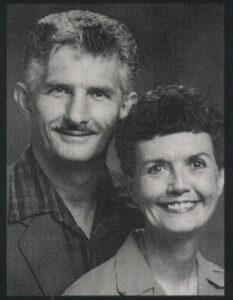
Charles and Dixie Austin his common law wife around the time of his arrest.
They had a common-law marriage, and Dixie was quite happy with Charles Albright. He was remodeling the house and buying a lot of construction materials. It was the perfect time for him to get a part-time job; he told Dixie he was taking on a paper route that required him to work nights to earn extra pocket money. Dixie was unhappy about him being away at night, but that’s exactly what Charles needed—a reason to be out when Oak Cliff’s prostitutes were on the streets.
The paper route rounded out the life and routines Charles Albright wanted for himself. He had prostitutes who trusted him enough to get in his car and go to one of his parents’ old properties ten minutes south of the Star Motel, where some prostitutes he knew hung out.
At this vacant rental property on Cotton Valley Rd, he could carry out the murders and remove the eyes of his victims. And because the property was in his father’s name, nothing could be traced back to the name “Charles Albright.”
But there was a subtle flaw in his careful plan to keep all that distant from himself. Something Albright couldn’t have known. Old Speedee, his truck-driving tenant, aka Axton Schindler, had a policy not to list his correct address on his driver license. Speedee was an “off the grid” kind of guy and didn’t want the government to know anything about him. So, the speedy-talking renter put down “1035 Eldorado,” which was the home address for Charles Albright.
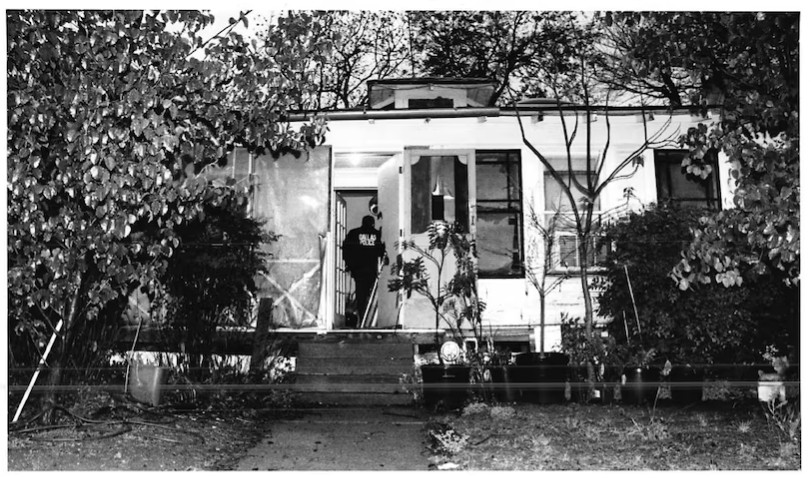
1035 Eldorado in Oak Cliff, Dallas
And on a rainy morning in March 1991, a search warrant was executed on Albright’s house and he was arrested. And you already know they found woodworking blades and X-Acto blades, plus other things, and then Charles Albright was handcuffed and arrested.
The primary evidence against him at trial was Brenda White’s testimony plus hair and fiber transference. Charles’ hairs were found on the bodies of his victims. Also, hairs from one of his victims were in the Albright home vacuum cleaner. There was also some fiber transference that implied guilt.

Montford Psychiatric Unit in Lubbock, Texas
Although I haven’t been able to ascertain why, Albright was incarcerated in the John Montford Psychiatric Unit in Lubbock, Texas, rather than in a regular prison unit. To my knowledge, he was not deemed insane at trial that I know of. However, he stayed there until 2020 when he passed away in the prison hospital at age 85.
I hope you enjoyed this story!
Until next time! Brenda
SOURCES:
Credits: My primary source was Skip Hollandsworth’s 19-page article “See No Evil” that appeared in Texas Monthly in May 1993. This is a short version in my own words except for one passage where I quoted his fabulous narrative.
Most of my pictures of Charles and the Albright family came from the same article.
I encourage you to read Hollandsworth’s deliciously long 19-page article.. He visited Charles Albright in prison in 1993 and spins an enthralling story about Albright’s life.

